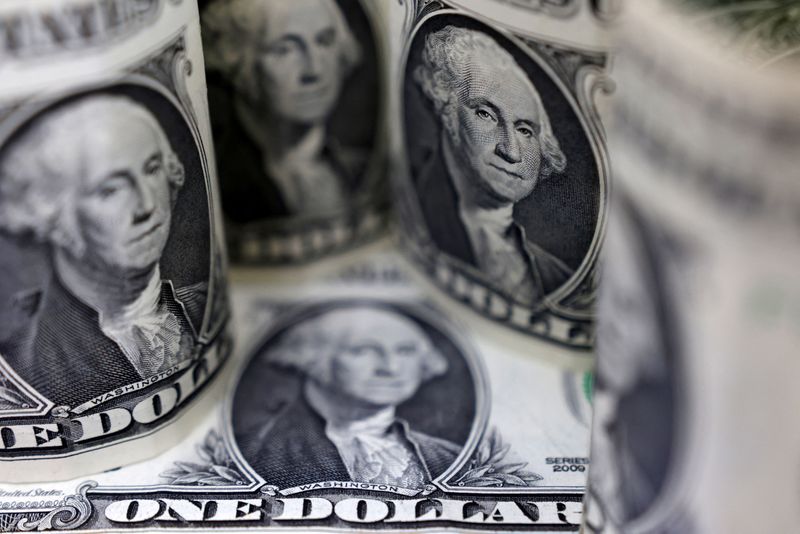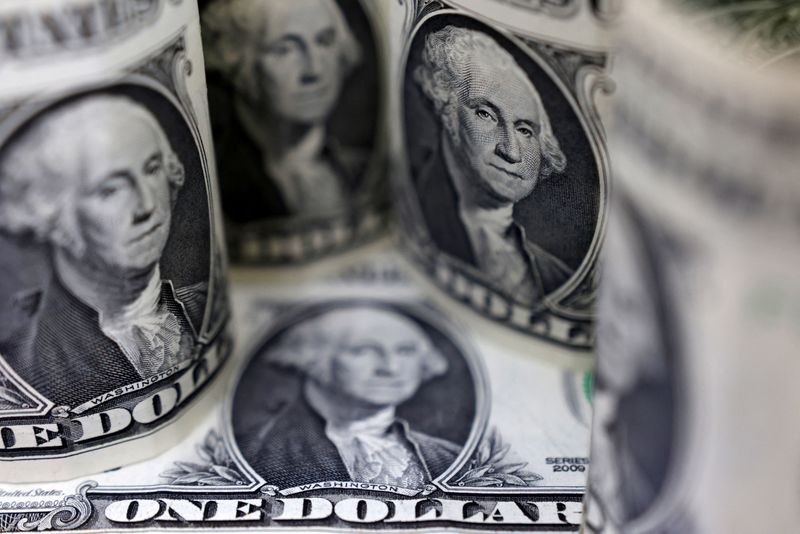Forex
Dollar touches 2-week high, euro soft as traders bet on Q1 rate cuts


© Reuters. U.S. Dollar banknotes are seen in this illustration taken July 17, 2022. REUTERS/Dado Ruvic/Illustration/File Photo
By Samuel Indyk and Ankur Banerjee
LONDON (Reuters) -The U.S. dollar touched a two-week high on Wednesday, while the euro was weak across the board as markets ramped up bets that the European Central Bank will cut interest rates as early as March.
The euro was down 0.2% against the dollar at a three-week low of $1.0773, as markets adjust rate expectations lower following soft data and dovish central bank commentary.
The single currency also touched a three-month low against the pound, a five-week low versus the yen and a 6-1/2 week low against the Swiss franc.
“The story in currency markets is mostly about a softer euro,” said Niels Christensen, chief analyst at Nordea.
“Yesterday’s comments from ECB’s Schnabel supported the market view of early rate cuts.”
Influential policymaker Isabel Schnabel on Tuesday told Reuters that further interest rate hikes could be taken off the table given a “remarkable” fall in inflation.
Markets are now placing around an 85% chance that the ECB cuts interest rates at the March meeting, with almost 150 basis points worth of cuts priced by the end of next year.
The ECB will set interest rates on Thursday next week and is all but certain to leave them at the current record high of 4%. The Federal Reserve and Bank of England are also likely to hold rates steady next Wednesday and Thursday respectively.
Fed officials are now in a blackout period ahead of the Dec. 12-13 meeting, where a key focus will be the updated projections of where they see rates in 2024.
Traders have priced around a 60% chance of the U.S. central bank cutting rates in March, according to CME’s FedWatch tool. They have also priced in at least 125 basis points of cuts next year.
Investors have been reassessing the extent of U.S. rate cuts next year in the past few days, helping lift the dollar.
“Markets have gone a bit overboard with pricing in very aggressive path of rate cuts through next year,” said Aninda Mitra, head of Asia macro and investment strategy at BNY Mellon (NYSE:) Investment Management.
Mitra said there could be a snapback should the Fed drive home the message more forcefully that it is not about to cut rates anytime soon.
“Our view is that Fed might hold off till the second quarter and even then the cuts would be a lot more shallower than what the market would like,” Mitra said.
The widely expected rate cuts from the Fed will result in the dollar loosening its grip on other G10 currencies next year, dimming the outlook for the greenback, according to Reuters poll of foreign exchange strategists.
The , which measures the currency against six other majors, was up 0.1% at 104.07, having touched a two-week high of 104.10 earlier.
The spotlight in Asia was on China, as markets grappled with rating agency Moody’s (NYSE:) cut to the Asian giant’s credit outlook.
The offshore rose 0.1% to $7.1694 per dollar, a day after Moody’s cut China’s credit outlook to “negative”.
The spot yuan rate opened at 7.1570 per dollar and was last changing hands at 7.1585.
China’s major state-owned banks stepped up U.S. dollar selling forcefully after the Moody’s statement on Tuesday, and they continued to sell the greenback on Wednesday morning, Reuters reported.
Elsewhere in Asia, the Japanese yen was down 0.1% at 147.29 per dollar. The Australian dollar rose 0.3% to $0.6574, while the New Zealand dollar rose 0.4% to $0.6154.
In cryptocurrencies, bitcoin eased 0.3% to $43,940 having surged above $44,000 earlier in the session.
The world’s largest cryptocurrency has gained 150% this year, fuelled in part by optimism that a U.S. regulator will soon approve exchange-traded spot bitcoin funds (ETFs).

 Forex3 years ago
Forex3 years agoForex Today: the dollar is gaining strength amid gloomy sentiment at the start of the Fed’s week

 Forex3 years ago
Forex3 years agoUnbiased review of Pocket Option broker

 Forex3 years ago
Forex3 years agoDollar to pound sterling exchange rate today: Pound plummeted to its lowest since 1985

 Forex3 years ago
Forex3 years agoHow is the Australian dollar doing today?

 Cryptocurrency3 years ago
Cryptocurrency3 years agoWhat happened in the crypto market – current events today

 World3 years ago
World3 years agoWhy are modern video games an art form?

 Commodities3 years ago
Commodities3 years agoCopper continues to fall in price on expectations of lower demand in China

 Economy3 years ago
Economy3 years agoCrude oil tankers double in price due to EU anti-Russian sanctions



























